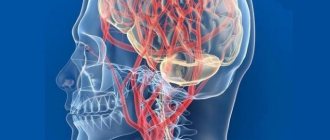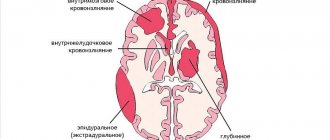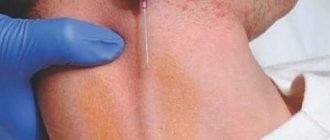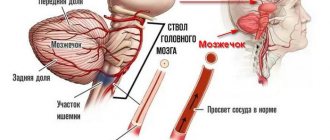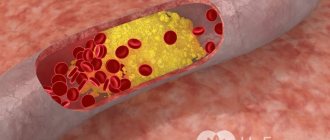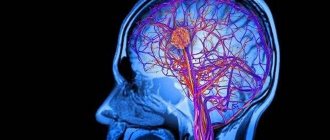Thrombosis of the cerebral sinuses is a very rare pathology, the neurological and clinical manifestations of which can be very diverse. Unfortunately, doctors currently have insufficient information regarding the likelihood of developing this disease in the presence of other diseases. By the way, not a single major study has been conducted in our country on this problem. That is why in most patients, cerebral sinus thrombosis is diagnosed untimely, often when the disease is at a late stage, which cannot but affect the duration of treatment and prognosis. In this regard, therapists and neurologists recommend contacting a medical facility if any alarming symptoms occur. Only based on the results of comprehensive diagnostics can one suspect the presence of sinus thrombosis in a patient and take all necessary measures in a timely manner.
Pathogenesis
Very often you can hear that the cause of death of a person was a blood clot. This term refers to a clot of liquid connective tissue, the formation of which occurs in a blood vessel. The thrombus consists of proteins, mainly fibrin. It can be obstructive or parietal. In the first case, it is customary to say that the thrombus completely blocks the lumen of the blood vessel, in the second - partially.
The formation of a clot of liquid connective tissue occurs for many reasons. Most often this is:
- Impaired blood flow.
- Change in the vessel wall.
- Increased viscosity of liquid connective tissue.
The pathogenesis of the disease is based on a violation of the blood supply to the brain, accompanied by the formation of clots. The latter can form in any part of the organ. According to statistical data, thrombosis of the superior sagittal sinus is most often diagnosed. It accounts for 60-98% of cases. In the lateral, direct and cavernous thrombi are found much less frequently. In addition, lesions can be localized in the cortical and deep veins.
Kinds
The following sinuses of the dura mater are distinguished:
- Sinus sagittalis superior. The superior sagittal sinus runs along the superior edge of the greater falx, from the cock's crest to the occipital internal protuberance.
- Sinus sagittalis inferior. The inferior sagittal sinus is located in the thickness of the free edge of the greater falx. It flows into the sinus rectus posteriorly. The connection is located in the area where the lower edge of the greater falx fuses with the anterior edge of the cerebellar tentorium.
- Sinus rectus. The straight sinus is located in the splitting of the tentorium along the line of attachment of the large falx to it.
- Sinus transversus. The transverse sinus is located at the origin of the tentorium cerebellum from the membrane of the brain.
- Sinus occipitalis. The occipital sinus lies at the base of the cerebellar falx.
- Sinus sigmoideus. The sigmoid sinus is located in the groove of the same name on the inner cranial surface. It looks shaped like the letter S. In the area of the jugular foramen, the sinus becomes the internal vein.
- Sinus cavernosus. The paired cavernous sinus is located on both sides of the sella turcica.
- Sinus sphenoparietalis. The sphenoparietal sinus is adjacent to the posterior free area on the lesser wing of the sphenoid bone.
- Sinus petrosus superior. The superior petrosal sinus is located at the superior edge of the temporal bone.
- Sinus petrosus inferior. The inferior petrosal sinus is located between the clivus of the occipital and the pyramid of the temporal bones.
Etiology
Despite the fact that the disease has not been studied well enough, medicine knows the causes of cerebral sinus thrombosis. They can be either infectious or non-infectious in nature.
In the first case, the reasons for the development of sinus thrombosis are as follows:
- Septic trauma.
- Subdural empyema.
- Abscess.
- Meningitis.
- Sinusitis.
- Otitis.
- Stomatitis.
- Tonsillitis.
- Septicemia.
- Tuberculosis.
- Endocarditis.
- Hepatitis.
- Measles.
- Herpes virus.
- HIV.
- Cytomegalovirus.
- Malaria.
- Toxoplasmosis.
- Trichinosis.
- Cryptococcosis.
- Aspergillosis.
Non-infectious causes of sinus thrombosis:
- Various types of head injuries.
- Condition after recent neurosurgical intervention.
- Meningioma.
- Cholesteatoma.
- Metastatic neoplasms.
- Blockage of the internal jugular vein.
- Condition after any surgical treatment.
- Pregnancy.
- Taking oral contraceptives.
- Nephrotic syndrome.
- Heart failure.
- Dehydration. Its etiology can be any.
- Neoplasms of a malignant nature.
- Thrombophilia (most often it is customary to talk about the presence of a congenital disease).
- Coagulation disorders.
- Crohn's disease.
- Cirrhosis.
- Vasculitis.
- Ulcerative colitis.
- Sarcoidosis.
- Long-term use of medications, in particular glucocorticosteroids, L-asparginase and aminocaproic acid.
In addition, the risk of developing sinus thrombosis increases after spinal and epidural anesthesia, as well as after lumbar puncture.
Symptoms
The clinical picture of the disease can be very diverse. Symptoms of sinus thrombosis and their intensity directly depend on the rate of occlusion of blood vessels.
The onset of the disease can be:
- Spicy. In this case, symptoms develop very quickly, in less than 48 hours.
- Subacute. Clinical manifestations may gradually increase over several days or even a month.
- Chronic. In this case, the intensity of symptoms increases over more than 30 days.
The main warning sign is headache. With sinus thrombosis, it begins subacutely. Its intensity increases over several days. During this time, the headache becomes resistant to the action of analgesics. Patients note that it is unbearable at night, which inevitably leads to sleep disturbances.
Painful sensations very rarely arise suddenly; more often they appear and develop within a day. Their intensity is always much higher during physical activity. In addition, headaches intensify when a person is in a horizontal position. It is often accompanied by neurological symptoms.
During a consultation with a doctor, patients complain not only of a headache, but also of discomfort in the eye area (it occurs due to swelling of the optic nerve head), as well as the presence of convulsive attacks, disturbances of consciousness, sensory and motor deficits.
Course and outcome
Sinus thrombosis, left to its own devices, is cured only in extremely rare cases. This occurs by organizing and channeling the clot. In the vast majority of cases, the resulting blood clots undergo purulent or putrefactive decay and, due to general infection of the body, death occurs. The cause of death is either general poisoning of the body, or the formation of metastases in vitally important organs (especially the lungs), or, finally, due to associated meningitis and brain abscess, or due to bleeding from the sinus or paralysis of the vagus nerve.
The duration of the process can vary: from several days to several weeks and even months.
Diagnostics
If any alarming signs occur (most often this is a severe headache that is resistant to the action of analgesics), you should consult a therapist or neurologist. The specialist will collect anamnesis, conduct a physical examination and issue a referral for a comprehensive examination.
When diagnosing a disease, clinical data should always be confirmed by instrumental neuroimaging methods. Most often, doctors recommend that patients undergo MRI of the head and cerebral vessels and CT. However, the diagnostic value of these methods directly depends on how long ago the disease arose. For example, at the initial stage of pathology development, MRI of the head and cerebral vessels may not be informative. In this regard, the main diagnostic method is CT.
Using computed tomography, it is possible not only to identify disorders even at their earliest stages, but also to differentiate them from other conditions that have a similar clinical picture (an example is intracranial hematoma, abscess, brain tumor, etc.).
In the acute stage of the disease, the most informative studies are MRI and CT venography. However, the latter method is more specific and has a higher degree of sensitivity.
In addition, according to clinical guidelines, sinus thrombosis is a pathology, during the diagnosis of which it is necessary to perform a general blood test, fundus examination and cerebrospinal fluid examination. The history taking must also be very thorough.
Treatment
The treatment regimen directly depends on what caused the development of sinus thrombosis. Treatment of an illness of an infectious nature involves taking broad-spectrum antibiotics, the active components of which are able to penetrate the blood-brain barrier. In addition, sanitation of the pathological focus using surgical methods is indicated.
Antibiotics are prescribed empirically until laboratory results are available. It is worth noting that most often the cause of the development of the disease is the active activity of streptococci and staphylococci.
As part of initial antibiotic therapy, the following drugs can be prescribed:
- III generation cephalosporins (Cefotaxime, Ceftriaxone, Ceftazidime), IV generation (Cefpirom, Cefmetazole).
- Beta-lactam antibiotics. Most often, doctors prescribe Meropenem.
- Glycopeptides (for example, Vancomycin).
- Alternative drugs. Experts prefer aminoglycosides and penicillins.
When non-infectious sinus thrombosis is detected, the fight against thrombus formation comes to the fore. Currently, the most effective drug is Heparin. It is used until the patient experiences visible positive changes. In most cases, heparin therapy is carried out for 1 week.
As part of the fight against blood clots, Curantil is often prescribed. This is an antiplatelet agent, the active component of which is dipyridamole, according to the instructions for use. The price of "Curantil" is about 700 rubles, which makes it affordable for most patients.
The dosage regimen is determined by the attending physician on an individual basis. Unless the specialist has indicated otherwise, it is necessary to take the information reflected in the annotation as a basis. 225 mg is the maximum dose according to the instructions for use.
The price of "Kurantil" is very justified. According to reviews from doctors, this drug is very effective against pathologies of the brain and cardiovascular system associated with thrombus formation and circulatory disorders.
Treatment of the disease also involves taking medications to thin the blood. This is due to the fact that thick liquid connective tissue cannot fully perform its functions, which only aggravates the course of the pathology. During treatment, blood clots also liquefy. Naturally, this has a positive effect on the course of the disease and makes the prognosis more favorable.
The most commonly prescribed medications for blood thinning are Cardiopyrin, Aspirin, Lamifiban, Magnecard. All drugs are selected individually based on medical history and diagnostic results.
If conservative methods of therapy are ineffective, the specialist makes a decision regarding the advisability of surgical intervention. There are several methods of surgical treatment, but currently the most popular is bypass surgery. The essence of the method is to create an artificial path bypassing the affected vessel. During the operation, open access is used, and therefore the intervention is performed under general anesthesia.
Treatment of dural sinus thrombosis
Since infections occupy a large part in the structure of the causes of cerebral vein thrombosis, antibiotics are prescribed from the first days of the disease, even before the exact localization of the purulent focus is identified. And they use third generation cephalosporins, Tienam, Meronem, Vancomycin.
To reduce the formation of blood clots in the vessels, Heparin injections are used intravenously for a week, then patients are transferred to indirect anticoagulants, antiplatelet agents: Warfarin, Clopidogrel. To eliminate fluid stagnation, diuretics, Eufillin, are used. Restoration of microcirculation is carried out with the drip administration of Reopoliglyukin, Pentoxifylline.
It may be recommended to introduce the following mixture into the vessels of the neck:
- solutions of sodium chloride 0.9% and Novocaine 0.5%,
- Heparin and Fibrinolysin,
- Vancomycin.
Features of pathology in children
Disorders of the blood supply to the brain are a pressing problem not only among the adult population. According to statistics, cerebral sinus thrombosis is diagnosed in 2 out of 100,000 children annually. Moreover, the superior sagittal sinus is most often affected. Lateral thrombosis is somewhat less common.
The main causes of the development of the disease in children:
- Genetic predisposition.
- Bacterial sepsis.
- Chicken pox.
- Purulent meningitis.
- Severe dehydration.
- Congenital heart pathologies.
- Liver diseases.
The clinical manifestations of the disease directly depend on the age of the child. Moreover, they can be expressed both weakly (drowsiness, excitability, appetite disturbances) and strongly (coma). In infants, sinus thrombosis most often manifests itself as generalized convulsions, depression and increased body temperature.
At older ages, the following symptoms appear:
- Headache.
- Vomit.
- Congestion in the fundus.
Treatment of pathology in children involves taking anticoagulants, thrombolytics and antiplatelet agents.
Clinic of cavernous sinus syndrome
A typical symptom of the pathology is pain in the facial area on one side. The sensations increase at night, after physical exertion. After some time, swelling of the eyelids and an increase in temperature occur.
Ophthalmological signs of cavernous syndrome:
- Exophthalmos;
- Ophthalmoplegia;
- Swelling of the facial nerve.
Clinic of bilateral cavernous sinus thrombosis:
- Convulsions of part of the face;
- Decrease in brain activity;
- Confusion;
- Lack of tactile sensitivity of the face.
The aseptic form is not accompanied by an increase in temperature. Septic thrombosis is combined with intoxication syndrome:
- Constant fatigue;
- Brokenness;
- Aching bones, muscles;
- Temperature 38-39 degrees.
Cavernous thrombosis is accompanied by a number of pathological syndromes:
- Difficulty in eye movement;
- Swelling of the eyelids;
- Doubling of objects, flickering of front sights.
A neurologist diagnoses sinus thrombosis, as symptoms of nerve damage appear. The specialist’s task is to carry out a differential diagnosis between nosology and inflammation of the paranasal sinuses (sinusitis).
Features of the disease in pregnant women and women in labor
According to statistics, sinus thrombosis is diagnosed in approximately 1-4 cases per 10,000 births. Moreover, the disease is most often detected in young and middle-aged women.
The main causes of the development of the disease in pregnant women and women in labor:
- Inflammatory processes in the sinuses of the nose, ear, face.
- Neoplasms of both benign and malignant nature.
- Hereditary mutations (for example, Leiden factor).
- Leukemia.
- Polycythemia.
- Behçet's disease.
- Antiphospholipid syndrome.
The first symptom is headache. Over time, it is accompanied by nausea, vomiting, and convulsive seizures. Possible disturbances of consciousness, in particular coma.
Treatment of the disease in pregnant women and women in labor involves intensive therapy using the above drugs. In addition, measures are being taken to correct intracranial hypertension and relieve seizures.
Classification of cavernous thrombosis according to ICD
The disease code according to the international classification of the tenth revision is “G08”. According to the outdated version of ICD 9, the nosological form was coded “325”.
Thrombophlebitis and phlebitis are designated "I80". Other varieties are coded according to the main nosology that contributes to blockage of the vessel.
Phlebitis of the facial veins and cavernous sinus is often detected. The etiological factor of the nosologies are inflammatory processes - osteomyelitis, boil, carbuncle. In children, hypothermia of the face can provoke trigeminal nerve syndrome, which is the main source of infection.
Anatomy of the sinuses of the brain
The strong bony framework of the skull protects the brain tissue from external damage, but the anatomy provides little opportunity to adapt to changing conditions within the skull.
Compression of the brain by a hematoma or tumor leads to pressure on internal anatomical structures. Depending on the localization of compression, a clinic is formed.
Sinuses of the brain:
- Rocky (upper, lower);
- Sagittal (upper, lower);
- Wedge-shaped;
- Transverse;
- Occipital;
- Straight;
- Sigmoid;
- Cavernous (cavernous);
- Jugular;
- Sigmoid.
The unique structure of large cerebral veins containing a dura mater allows them to maintain their shape. The constant gaping of the lumen provides a danger for the penetration of microbes. Thrombophlebitis of the ophthalmic veins increases the risk of cavernous sinus thrombosis.
Signs of thrombophlebitis of the cavernous sinus
Early detection and timely treatment can eliminate irreversible damage to the cranial nerves:
- Throbbing, pressing headaches;
- Blueness of the eyes due to swelling of the optic nerve;
- Gaze paralysis;
- Loss of sensation in the upper part of the face;
- Hyperthermia.
The advanced stage is characterized by loss of consciousness, convulsive syndrome, and disorders of the hormonal system.
Nutritional Features
After treatment, each patient should know which products prevent the formation of blood clots. In addition, dietary adjustments can be considered as primary prevention of the disease.
The menu must include products that help thin the blood and prevent the formation of clots of liquid connective tissue.
These include:
- Vegetables and fruits rich in vitamin C (citrus fruits, grapes, sour apples, lingonberries, blueberries, plums, cherries, apricots, peaches, garlic, onions).
- Berries (raspberries, blackberries, strawberries, blueberries, currants). They can be consumed fresh or made into juices and smoothies.
- Sprouts of legumes and grains (peas, oats, buckwheat, wild rice). Against the background of their regular use, blood vessels are cleansed.
- Tomatoes.
- Bell pepper.
- Green pea.
- White cabbage.
- Lightly salted cucumbers.
- Carrot.
- Bee products, especially honey.
- Ginger.
- Dill.
- Parsley.
- Horseradish.
- Cinnamon.
- Vegetable oils.
During the diet, you should avoid foods that negatively affect blood circulation, cause an increase in platelet growth and increase the risk of blood clots.
The following products should be excluded from the menu:
- Nuts.
- Cheeses with high fat content.
- Bananas.
- Potato.
- Sweet drinks.
- Strong tea.
- Marinades.
- Canned food.
- Meat.
- Milk.
- Alcohol.
Forecast
The outcome of the disease directly depends on the severity of the patient’s condition, the timeliness of diagnosis and treatment.
The following prognostic signs are unfavorable:
- Depression of consciousness.
- Deep coma.
- Sepsis.
- Epileptic seizures that are extremely difficult to stop.
- Hemorrhagic infarctions.
- Pulmonary embolism.
According to available data, complete recovery occurs in approximately 50-75% of patients. Residual effects are diagnosed in approximately 29% of cases. Death occurs in 5-33% of patients.
If the diagnosis is not made in a timely manner and there is no treatment for a long time, the risk of developing the following complications significantly increases:
- Swelling of the brain substance.
- Venous infarction.
- Purulent meningitis.
- Thrombophlebitis of the retinal veins.
- Metastatic abscesses in the lungs.
- Epilepsy.
- Brain abscess.
- Septic pneumonia.
In order to prevent the onset of negative consequences that pose a danger not only to life, but also to health, it is necessary to contact a medical facility as soon as possible when the first alarming symptoms appear. Regular and intense headaches, which are difficult to relieve with analgesics or are completely resistant to them, should be especially alarming.
In addition, as part of the primary prevention of the disease, it is recommended to lead a healthy lifestyle, which includes regular physical activity. Physical activity prevents the formation of blood clots. It is also important to make adjustments to the diet; the menu should be balanced.

